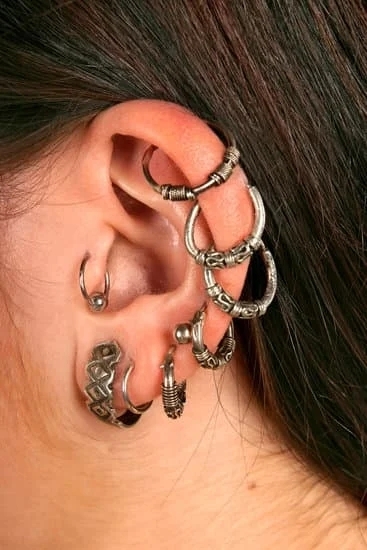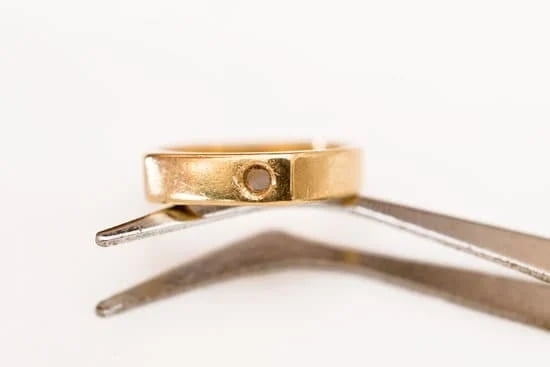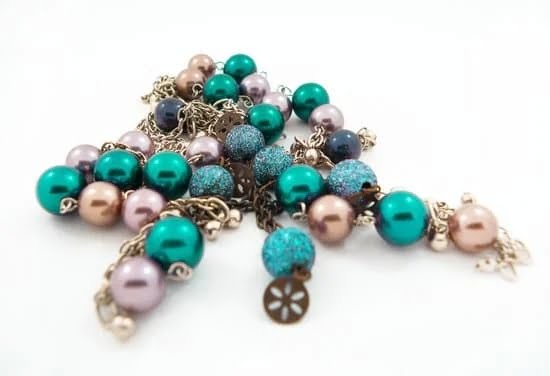Jewelry material that doesn’t tarnish is a great choice for anyone looking to buy a piece of jewelry with a longer-term wearability. Many jewelry materials, when exposed to air, gasses, and moisture can start to corrode or develop an off-color patina over time which can be unsightly. Jewelry materials that don’t tarnish offer many advantages over other options.
They are durable and resistant to corrosion, making them far less likely to change color overtime. Additionally, they don’t require excessive cleaning or maintenance in order to ensure they maintain their original appearance – saving you time and money in the long run.
Gold Alloys
One of the most popular jewelry material that doesn’t tarnish is gold alloys, also known as white gold or rose gold. Gold alloys are created by combining pure gold with one or more metals such as zinc, copper, nickel, silver and palladium in order to make them harder than pure gold yet still pliable enough for jewelry purposes.
Gold alloys have an attractive glossy finish and are highly resistant to chipping or breakage. While these metal blends do scratch more easily than other materials on the Moh’s scale of hardness (with a rating of 6-7), they do not corrode or discolor overtime when exposed to air and moisture due.
Titanium & Tungsten Alloys
The most popular non-tarnishing metals used in contemporary jewelry designs are titanium & tungsten alloys. These two metal alloys offer a distinctive look compared with other more traditional precious metals. Additionally, tungsten alloy rings guarantee superior weight and toughness – making them extremely scratch resistant with no fear of fading over time due their higher hardness score of 8½ on the Moh’s scale.
They also come in various colors such as dark grey/black for those who crave a far more subtle look compared expensive but less durable platinum metals like white gold or silver. Compared to brassalloy alternatives , Titanium & Tungsten alloys remain strong while being lightweight and comfortable enough to wear daily if desired – making them ideal choices those looking for solid long lasting pieces made from sturdy materials that don’t tarnish.
Common Metals and Ceramics That Don’t Tarnish
Gold is perhaps one of the most desirable metals for making jewelry. It is also one of the few materials that doesn’t tarnish, meaning it will last a lifetime without losing its color or luster. Gold’s resistance to corrosion and tarnishing make it a great choice for luxurious and timeless jewelry designs.
As well as being resistant to tarnish, gold is extremely malleable, which means that intricate and complex designs can be carved into it. As for gold purity, 9K and 14K are the most popular gold standards used in jewelry as they provide an excellent balance between hardness and price.
Platinum is quite similar to gold when it comes to making fine jewelry but even more durable than gold and has a subtle white sheen to it. Although some platinum alloys can still discolor over time, pure platinum won’t tarnish since it’s almost immune to oxidation or other types of corrosion that usually cause metals to rust.
It’s also stronger than gold so it can better withstand impacts such as everyday wear and tear. Platinum alloy rings usually consist of at least 90 percent platinum content which makes them pricier than gold rings but their superior strength makes them worth the added cost.
Stainless steel is another tough material that doesn’t corrode easily and resists tarnishing. Not only does it look sleek and stylish, but stainless steel is less expensive than other precious metals making it a great option for budget-friendly jewelry items such as earrings, necklaces, pendants, rings and bracelets.
Due to its resistance to discoloration from exposure to air pollutants or strong acids, stainless steel does not require regular maintenance like most jewelry pieces do however be careful when handling this type of metal as its strength may come at the consequences of scratching more easily then other softer metals such as silver or gold alloys./.
Overview of Non-Tarnishing Jewelry Making Processes
Casting is a jewelry making process that involves pouring liquefied metal into a mold. After the metal has cooled and hardened, it can be taken out of the mold and polished until it is entirely free of imperfections. Silver, gold, bronze and brass are just a few examples of metals that can be used for casting.
This method is often used for intricate designs since the details can easily be replicated by the mold. There are plenty of non-tarnishing options when it comes to casting; stainless steel and titanium are two of them.
The next step in creating non-tarnishing jewelry would be plating. This technique adds an extra layer of protection to your jewelry by adding another metal over its existing surface. Plating is usually done through an electroplating process which involves depositing a very thin layer of a precious metal over another base metal such as iron, steel or brass.
The advantages of plating include improving the luster and shine but also making jewelry more durable and less susceptible to tarnish. Gold, silver, rhodium and platinum are commonly used metals in plating due to their naturally non-oxidizing properties.
Finally, we come to hammering which is an ancient technique but still relevant today in the jewelry industry. Hammering gives you control over how thick or thin you want certain parts of your design to be while also achieving different textured finishes like matte or shiny.
It’s relatively more inexpensive than other forms of metalworking because no special tools other than hammers are needed for this process; it’s also around eight times faster than casting when it comes to product production outcome times. Hammered pieces are generally oxidized further by dipping them in anti-tarnish solutions or using protective coatings before being put on display so that their shine lasts longer without the need for frequent polishing activities afterward.
Advantages of Non-Tarnishing Jewelry Materials
When it comes to jewelry, material choice is incredibly important. Some materials are prone to oxidize and tarnish over time, which can greatly impact the appearance of the piece. Thankfully, there are several options when it comes to jewelry materials that won’t tarnish.
One of these is titanium. This strong lightweight metal is resistant to corrosion and oxidation, making it a perfect choice for jewelry that you don’t have to worry about tarnishing. It also has an extreme color retention; its golden or silver hues never fade over time.
It is available in a variety of styles and colors, both plain and textured, so you can find something to match your style perfectly. Titanium usually just needs a wipe down with soap and water every once in awhile, so it’s low maintenance as well as non-corrosive.
Another great option for non-tarnishing jewelry is stainless steel. Stainless steel jewelry also has characteristically high resistance against corrosion and oxidation, retaining its elegant silver hue for years with minimal polishing required. If your stainless steel jewelry does get dulled up over time, using some polishing cloths should be able to bring the shine back in no time flat. On top of being non-tarnishable and low maintenance, stainless steel looks good with just about any outfit or style.
Finally zirconium is yet another option for pieces of jewelry that you don’t want to lose their shine in time. It doesn’t corrode or rust like other metals may do; instead it stays silvery white with no discolorations making it ideal for crystal encrusted pieces or those featuring elaborate details that need regular cleaning. Zirconium also maintains its color tone even after repeated cleaning cycles (soap and water usually.), thanks to its superior corrosion resistance.
Innovative Jewelry Made from Non-Tarnishing Materials
Experience jewelry that won’t tarnish over time. Non-tarnishing jewelry is gaining popularity due to its fabulous array of modern styles and low maintenance requirements.
Unlike traditional metals such as silver, non-tarnish items don’t require cleaning or polishing. Not only does this save time, but money too – by investing in jewelry made from non-tarnishing materials you’ll minimize reoccurring costs over the life of the item, as well as reducing waste given the lack of need to buy harsh polishing chemicals or replacement items.
When chosen correctly, modern alternatives are easier on the wallet without sacrificing style, showcase a range of epic statement pieces like bangle bracelets with real botanicals embedded in Lucite acrylics and earrings made out of glimmering swarovski crystals which will make sure you sparkle under any light. Notable brands like Alex & Ani have stepped into the scene with hand stamped rings crafted from stainless steel and crafted shapes embedded with stones.
No matter what your preference may be there’s no shortage of beautiful options that don’t compromise on quality when choosing non-tarnishing pieces for your wardrobe.
Don’t let traditional buying habits hold you back from experiencing something new and completely aluminum free. Don’t forget about vegan leather either; a cruelty free option for those seeking an environment conscience fashion choice.
There are some designers that even favor upcycling old leather materials that would have typically gone unused into unique luxury pieces; perfect for those yearning for guilt free accessorizing. Take it a step further by adding sustainable Swarovski zirconia onto pieces featuring these elements which gives off a feeling that your novel accessory has been almost entirely consciously sourced.
Guidelines for Caring for Non-Tarnishing Jewelry
When it comes to jewelry, the last thing you want to worry about is regularly re-dipping and polishing it to prevent tarnish. Non-tarnishing jewelry materials are a great option in these cases, as they generally require very little care. The most popular metals used to make this type of jewelry are stainless steel, titanium, tungsten, and ceramic.
Gold or silver plated pieces may also be non-tarnishing if the plating is applied correctly. Aside from choosing the right material for your jewelry, there are several precautions that can be taken when caring for your pieces.
First and foremost, it’s important to keep your jewelry clean. Gently wipe your pieces with a damp cloth after each wear; however, you should avoid actual cleaning solutions, as some could corrode or discolor the metal if not compatible with its composition.
Use of a soft cloth and non abrasive cleaner will suffice for most occasions. If a piece has gemstones or other materials attached to it such as pearls, use only water and cloth when wiping down this type of jewelry.
Storage is equally important when caring for any type of jewelry; however this is especially true in regard to non-tarnishing pieces. Jewelry boxes made of leather or felt not only look aesthetically pleasing but also help minimize damage caused by friction or UV rays due to its soft material properties.
When storing multiple pieces in the same box its best practice to separate them ensuring they do not accidentally rub against one another which may cause scratches or weaken certain components over time. You should also store all non-tarnishing jewelry away from moisture sources such as sinks/showers when not being worn as contact with water can also lead to corrosion on certain metals over time despite their protective qualities against environmental agents such as air pollution.
Costs of Non-Tarnishing Jewelry
Jewelry is often an expensive purchase, and tarnishing can ruin the look of even the most expensive pieces. For those wanting to avoid this problem, non-tarnishing jewelry is a great option. These materials are available in a wide range of styles and prices, making it easy to find something that fits any budget without sacrificing quality or longevity.
Pricing can vary based on many different factors such as design and material used, making it difficult to get a general idea of average cost for non-tarnishing jewelry. Certain metals such as platinum, stainless steel, and titanium will generally be more expensive than gold and silver options due to their rarity; however there are many other types of jewelry materials like ceramic and tungsten that may be priced similarly to precious metals but will not tarnish over time.
Some samples of price comparison between various materials include stainless steel rings for men which start at around $25 compared with gold versions typically priced at $150-200; titanium cufflinks could cost anywhere from $80-$200 while sterling silver versions might go for about double that amount.
Non-tarnishing jewelry does come at a cost when compared with other materials, but investing in these pieces can save you from trying to restore tarnished items or replacing them altogether in the future. There is a much wider selection available than just precious metals so you’re sure to find something that fits both your budget and your style without sacrificing quality.
With proper care these pieces should last a lifetime but they also come with durable finishes so you don’t have to worry about polishing or cleaning all the time either. Whether you’re looking for casual pieces or formal wear, investing in non-tarnishing jewelry ensures your investment will never be ruined by oxidation or discoloration caused by environmental exposure.
Conclusion
Modern jewelry that doesn’t tarnish can be a great option for those looking for stylish and attractive pieces without the hassle of ongoing maintenance. The most common materials associated with durable, non-tarnishing jewelry are stainless steel and titanium, both of which have unique benefits not present in other traditional materials.
When searching for jewelry that doesn’t tarnish, look for pieces made from stainless steel or titanium for superior quality and long lasting performance. Stainless steel has many advantages over other materials because it is highly corrosion resistant, strong, durable and ideal in all types of climates.
Furthermore, it’s available in a variety of colors and styles to suit different tastes and preferences. Titanium is also a great choice because it is lightweight yet strong and hypoallergenic so it’s perfect for any skin type.
In conclusion, jewelry material that doesn’t tarnish provides a great combination of convenience, value and aesthetics to those who prefer low-maintenance pieces that can last the test of time. With the wide range of colors, textures and styles available in stainless steel and titanium options, shoppers have plenty of choices to find their perfect piece without worrying about frequent cleaning or damage caused by oxidation over time.

Welcome to my jewelry blog! My name is Sarah and I am the owner of this blog.
I love making jewelry and sharing my creations with others.
So whether you’re someone who loves wearing jewelry yourself or simply enjoys learning about it, be sure to check out my blog for insightful posts on everything related to this exciting topic!





